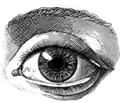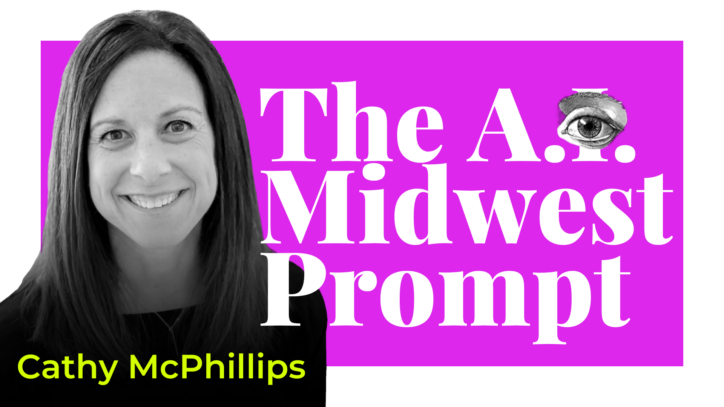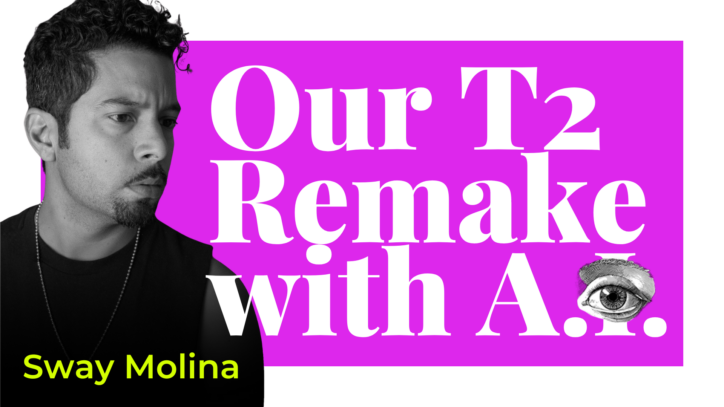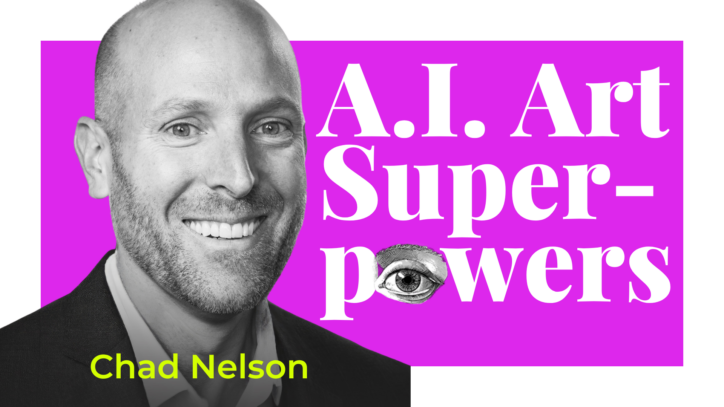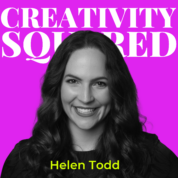
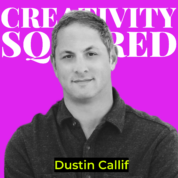

Ep70. Creative at the Speed of Culture and GenAI: Move Over PR Stunts & Discover A.I.’s Business Value in Commercial Advertising from Dustin Callif, President of Tool
From innovating custom A.I. solutions in advertising since 2016 to revolutionizing how brands create content at the speed of culture, meet Dustin Callif.
“Tool has been working in the fields of innovation, A.I., AR, VR, mixed reality since 2016, and we’re leveraging it both for content creation and in our workflows with clients.”
Dustin Callif
As President of Tool, a creative production partner based in Santa Monica, Dustin leads a team that blends traditional filmmaking with cutting-edge A.I. technology to create groundbreaking commercial content for some of the world’s most recognized brands, like Toyota, T-Mobile, and Coca-Cola. He is also responsible for founding Tool’s Experience group, which has been at the forefront of experiential design and creative technology.
Dustin’s projects have been recognized with over a thousand awards, including two Emmys, a Cannes Lions Palme d’Or, and honors from the Webby Awards, the Clios, One Show, SXSW, and many more. In addition to being a Forbes contributor on A.I. and advertising, Dustin is also a sought-after advertising judge and speaker, gracing the stages at conferences like SXSW, Collision, Cannes Advertising Festival, and more.

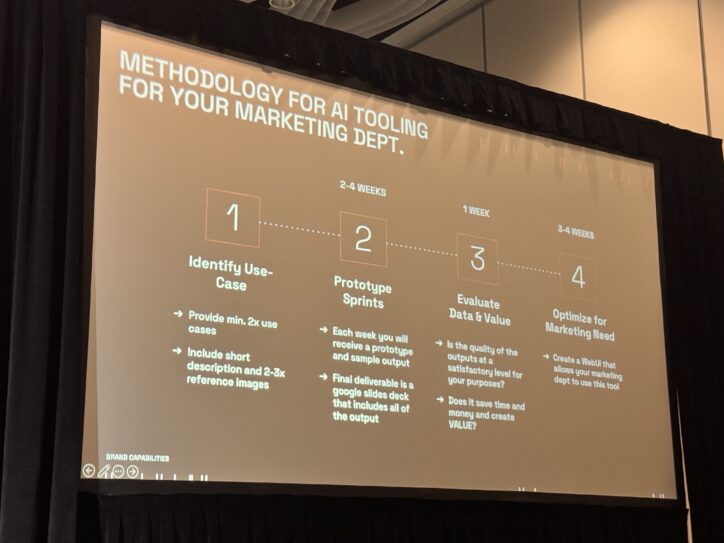
Dustin and Creativity Squared host Helen Todd were both speakers at MAICON, the Marketing AI Institute’s conference, where he shared on stage Tool’s approach to developing their evolved creative production model. They blend traditional filmmaking and creative strategy with A.I. to provide unique solutions for brands, including training A.I. on a brand’s owned assets.
In today’s conversation, you’ll hear how Tool is pushing the boundaries of A.I. in advertising while maintaining high creative standards and commercial viability through their campaign work in addition to workflow and content pipeline optimization. Dustin shares impressive case studies, including how they created a television commercial for Under Armour in four weeks without the actual talent, all enabled by A.I. and traditional post-production editing. Another one is an innovative approach of creating modular content for Starburst that is different every time for the viewer, deploying what he calls “A.I. Style Transfer.”
Not only does Tool put A.I. to work, but they also identify world-class A.I. talent, matching directors, like Creativity Squared guest Nem Perez, with innovative agencies and brands. We also discuss the evolving legal landscape around A.I.-generated content for brands.
Join us for an insider’s look at how A.I. is transforming advertising and content creation from one of the industry’s leading innovators who not only embraces the creative possibilities but leverages A.I. to drive real business value and efficiency.
Continue reading to discover more about Helen and Dustin’s conversation!

The Evolution of A.I. in Creative Production
Tool’s journey with A.I. began in an era of bespoke solutions and predictive analytics. Dustin recalls an early project with Toyota that required four months to train A.I. on 20 headlines written by copywriters to generate thousands of personalized Facebook ad variations. While groundbreaking at the time, this process seems almost quaint compared to today’s capabilities.
“Fast forward to now, and ChatGPT and all the other LLMs… the things that we had in our minds and the things we wanted to do, we’re now on the cusp of being able to do them.”
Dustin Callif
The emergence of generative A.I. in summer 2022 marked a turning point, enabling the creation of images, video, audio, and text with unprecedented ease.
Case Study: Under Armour’s A.I.-Enhanced Commercial
One of Tool’s most innovative recent projects showcases the power of their mixed media approach to A.I. content creation.
When Under Armour needed to create a commercial featuring Anthony Joshua ahead of his boxing match with Francis Ngannou, they faced two significant challenges: no physical access to Joshua during his training camp and a tight three-week production timeline.
They took a mixed media approach which Dustin explains is a really smart approach to creating marketing content with A.I. tools.
“If you are trying to do a commercial at the level of fidelity that a Fortune 1000 brand is going to need, A.I. is probably not going to be at the fidelity level that you’re going to need.”
Dustin Callif
The solution combined traditional CG for high-fidelity elements like Joshua’s face, A.I.-generated imagery for backgrounds and motion graphics, and existing commercial footage. The team generated over 5,000 images, ultimately selecting 52 for the final commercial.
Perhaps most impressively, the voiceover was entirely A.I.-generated using ElevenLabs, trained on Joshua’s voice tonality — a solution that proved both authentic and practical, allowing the athlete to focus on training.
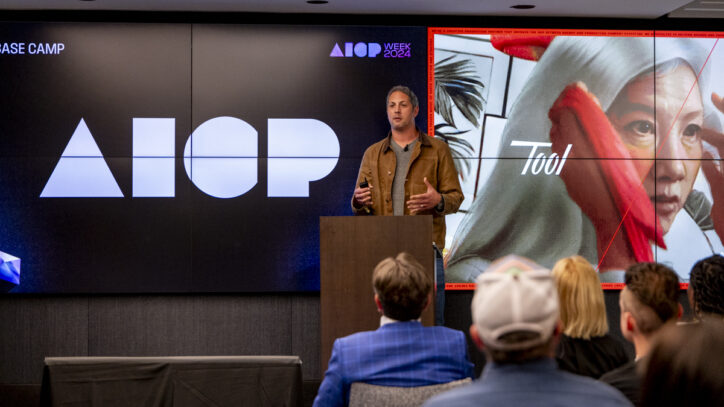
Ensuring Commercial Safety and Brand DNA
In today’s evolving legal landscape around A.I.-generated content, Tool has developed a methodical approach to ensure commercial safety for brands.
“Our success has been in helping a brand train on owned assets, meaning taking licensed assets from a Getty library or an Adobe-generated, and these are specifically the approved images that are also permitted for use with A.I.”
Dustin Callif
This careful approach helps legal teams feel confident about A.I. implementation while maintaining brand integrity.
To further enhance this process, Tool created TOOLKIT, a proprietary software that helps brands train A.I. on their visual DNA. By the end of 2024, this managed software will become fully autonomous, allowing brands to upload their images and styles for A.I. training. The result enables consistent, brand-compliant content generation across platforms like Adobe Firefly, Leonardo, and Canva.
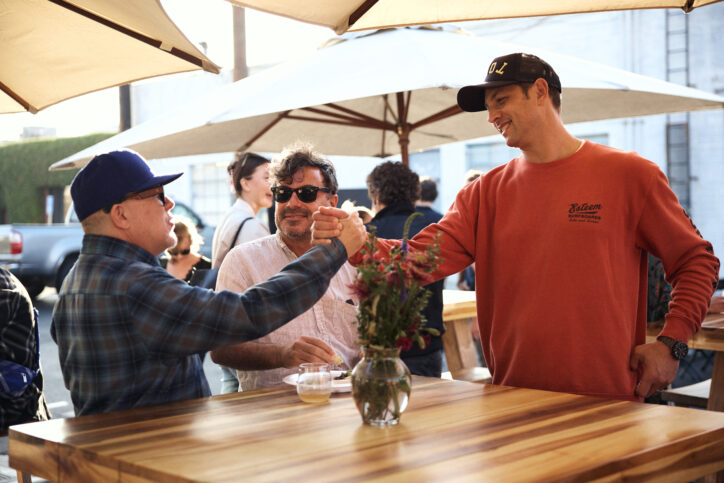
Representing A.I. Artists and Cultural Innovation
Tool’s innovative approach extends to talent representation, with the company maintaining a roster of A.I. directors and artists alongside traditional creative talent.
“We have a roster of A.I. directors. We have a roster of experiential directors. Our roster of A.I. directors is about four people right now.”
Dustin Callif
Among these talents is King Willonius, whose song “BBL Drizzy” made history when Drake and Metro Boomin sampled it — marking the first instance of A.I.-generated music being leveraged by major artists. Recently named to TIME’s 100 most innovative people in A.I., King Melonius exemplifies how A.I. artists can tap into cultural moments to create viral impact. Another notable talent is Creativity Squared guest Nem Perez, a filmmaker and A.I. artist whose work bridges traditional filmmaking with innovative A.I. applications. These partnerships allow Tool to offer brands cutting-edge creative solutions while staying ahead of cultural trends.
Modular Creativity: The Starburst Case Study
Tool’s innovative approach to A.I.-enhanced content creation is further illustrated by their work with Starburst. Working with agencies DDB Chicago and Critical Mass, the team addressed the challenge of Gen Z audience ad fatigue by creating multiple versions of content using a modular creative approach so the audience sees “something different every time.”
The project combined traditional filming with A.I. style transfer to generate 84 unique versions of the advertisement, plus over 300 versions when including different aspect ratios. This innovative solution demonstrated how A.I. can help brands maintain engagement while efficiently scaling content production.
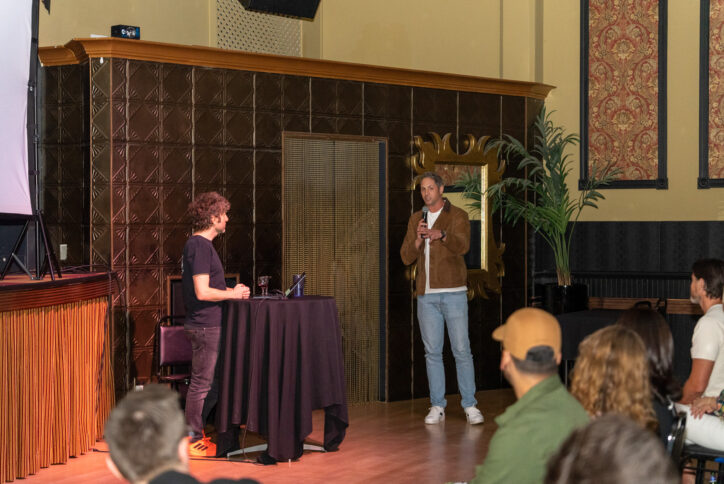
The Future of Creative Production
When asked about the future, Dustin emphasizes the importance of interoperability and open-source thinking in A.I. development. Rather than creating walled gardens, he hopes to see more collaboration and sharing of knowledge across platforms and the industry.
“I hope that we’re moving into an era where it’s more interoperable, and we can use APIs and things because, without that, I just find that we kind of block off innovation.”
Dustin Callif
Tool exemplifies this philosophy by openly sharing their processes and pipelines, helping to demystify A.I. and demonstrate its potential as a force for positive change in the creative industry.
As the conversation draws to a close, Dustin leaves listeners with a powerful reminder about the role of human creativity in an A.I.-enhanced world:
“There is craft in creating content with A.I. — are some of the roles in our world of creativity going to shift and change? Absolutely… But I want people to understand that there can be a high level of craft, and we shouldn’t just be okay with crappy A.I. content.”
Dustin Callif
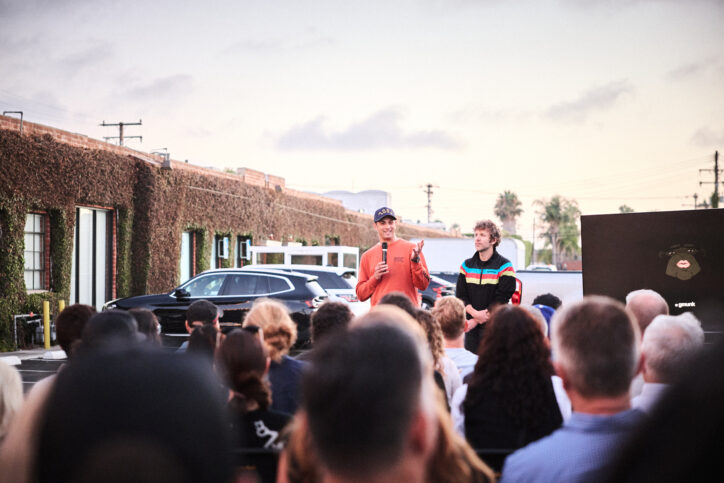
Links Mentioned in this Podcast
- Tool
- Forbes Profile
- SXSW
- Cannes Advertising Festival
- MAICON
- Under Armour
- ElevenLabs
- TOOLKIT
- TIME’s 100 most innovative people in A.I.
- Ep. 33 Creativity Squared with Nem Perez
Continue the Conversation
Thank you, Dustin, for joining us on this special episode of Creativity Squared.
This show is produced and made possible by the team at PLAY Audio Agency: https://playaudioagency.com.
Creativity Squared is brought to you by Sociality Squared, a social media agency who understands the magic of bringing people together around what they value and love: https://socialitysquared.com.
Because it’s important to support artists, 10% of all revenue Creativity Squared generates will go to ArtsWave, a nationally recognized non-profit that supports over 150 arts organizations, projects, and independent artists.
Join Creativity Squared’s free weekly newsletter and become a premium supporter here.
TRANSCRIPT
[00:00:00] Dustin: The thing I’m most excited about is that when it comes to innovation in particularly advertising and media, innovation is really helpful when you’re making a film. If you can use visual effects or tech in a certain way to solve a creative problem. In the world of commercial advertising, innovation is usually only used to generate stunts and PR headlines.
[00:00:21] Dustin: And I think where it excites me with AI is that AI isn’t just about the stunts and the PR headline, there’s actually real business value and efficiencies that can be had. And that is a huge, huge thing.
[00:00:34] Helen: From innovating custom AI solutions in advertising since 2016 to revolutionizing how brands create content at the speed of culture, meet Dustin Callif.
[00:00:47] Helen: As president of Tool, a creative production partner based in Santa Monica, Dustin leads a team that blends traditional filmmaking with cutting edge AI technology to create groundbreaking commercial content for some of the world’s most recognizable brands like Toyota, T Mobile, and Coca Cola. He is also responsible for founding Tools Experience Group, which has been at the forefront of experiential design and creative technology.
[00:01:15] Helen: Dustin’s projects have been recognized with over a thousand awards, including two Emmys, a Cannes Lions Palme d’Or, and honors from the Webby Awards, The Clios, One Show, South by Southwest, and many more. In addition to being a Forbes contributor on AI and advertising, Dustin is also a sought after advertising judge and speaker, gracing the stages at conferences like South by Southwest, Collision, Cannes Advertising Festival, and more.
[00:01:47] Helen: Dustin and I were both speakers at MAICON. The Marketing AI Institutes conference where he shared on stage Tool’s approach to developing their evolved creative production model. They blend traditional filmmaking and creative strategy with AI to provide unique solutions for brands, including training AI on a brand’s owned assets.
[00:02:11] Helen: In today’s conversation, you’ll hear how Tool is pushing the boundaries of AI in advertising while maintaining high creative standards and commercial viability through their campaign work. In addition to workflow and content pipeline optimization, Dustin shares fascinating case studies, including how they created a television commercial for Under Armor in four weeks without the actual talent, all enabled by AI and traditional post-production editing.
[00:02:44] Helen: Another one is an innovative approach of creating modular content for Starburst that is different every time for the viewer deploying what he calls AI style transfer. Not only does Tool put AI to work, but they also identify world class AI talent, matching directors, like Creativity Squared guest, Nim Perez, with Innovative Agencies and Brands.
[00:03:12] Helen: We also discuss the evolving legal landscape around AI generated content for brands. Join us for an insider’s look at how AI is transforming advertising and content creation from one of the industry’s leading innovators who not only embraces the creative possibilities, but leverages AI to drive real business value and efficiency.
[00:03:39] Helen: Enjoy.
[00:03:46] Helen: Welcome to Creativity Squared. Discover how creatives are collaborating with artificial intelligence in your inbox on YouTube and on your preferred podcast platform. Hi, I’m Helen Todd, your host, and I’m so excited to have you join the weekly conversations I’m having with amazing pioneers in the space.
[00:04:05] Helen: The intention of these conversations is to ignite our collective imagination at the intersection of AI and creativity to envision a world where artists thrive.
[00:04:22] Helen: Dustin, welcome to Creativity Squared. It is so great to have you on the show.
[00:04:27] Dustin: Thank you very much. Great to be here.
[00:04:28] Helen: So Dustin and I met at MAICON, which is the Marketing AI Institute’s marketing AI conference that they host in Cleveland. And he did a fantastic presentation on how AI can revolutionize your marketing pipeline.
[00:04:42] Helen: So super excited to have you on the show today. And for those who are meeting you for the first time, can you share who you are, what you do, and a bit of your origin story?
[00:04:51] Dustin: Sure. So, like you mentioned, my name is Dustin Callif and I am the president at a creative production partner called Tool. We’re based in Los Angeles, specifically Santa Monica, and our specialty is helping brands and advertising agencies either produce and create commercial content.
[00:05:11] Dustin: So the commercials that, unfortunately, not as many of us are watching on TV, we also help brands with experiential activations and events. And I would say the glue that kind of connects everything is we also have this creative technology group and we’ve been working in the fields of innovation, AI, AR, VR, mixed reality, but AI really since 2016 and we’re leveraging it both for content creation.
[00:05:37] Dustin: So now we’re creating commercials using AI. We’re also using AI in our workflows with clients to show them how they can more efficiently produce certain types of content like product photography. And we’re using AI in the experiential side of our business to help brands personalize their activations.
[00:05:54] Dustin: So that’s a little bit of, who and what Tool is. I can get into more details later because we work on a lot of interesting [things]. We have full time staff, but we also represent talent. So we actually represent some really interesting AI artists and creators in the space. I’ve had the great fortune of speaking at a lot of different conferences like MAICON, where we met, we actually just had LA Tech Week here this past week, and we just did a big talk, about using AI to automate the creation of lower funnel content, and King Willonius did a talk with us, who we represent, I’ll maybe mention him later, but King Willonius, he created this song over the summer called BBL Drizzy, that completely popped off.
[00:06:37] Dustin: It was all generated in AI. Well, I should say he wrote the lyrics, but then he used AI and Udio to generate all these versions. And Drake and Metro Boomin actually sampled it for two separate songs. And it’s the first example of like, AI music being actually leveraged by super popular artists. So, he just got named at Time’s 100 most innovative, you know, people in the world of AI.
[00:07:00] Dustin: So anyway, lots of fun stuff happening, you know, in the world. And I can’t wait to talk to you about it all. You tell me if you want me to get into more of my origin story or if I, if we want to just keep going, I know I just said a lot. So I want to take a pause and see where you want me to go.
[00:07:13] Helen: Well, this will be the easiest interview, you just keep going.
[00:07:18] Dustin: Yeah, exactly. I’m like, “oh no!”
[00:07:20] Helen: I think the only thing that I’ll point out that you mentioned before we started recording is that you’re originally from Cincinnati and the show is headquartered in Cincinnati. I live here. And a lot of people don’t realize what’s happening in Cincinnati as like being a hub for responsible AI.
[00:07:36] Helen: So it’s great, that you’re a native Cincinnatian, in LA now.
[00:07:41] Dustin: Yes, for sure. I am hoping that you could maybe send me some Skyline chili afterwards. It’s one of my favorites.
[00:07:49] Helen: I will do my best. So, okay. So there were so much that you said in your introduction and so many different ways we can go, but let’s kind of start, I guess, with like the lay of the land from the seat that you said, cause you’re definitely early I guess adopter agency with all the new gen AI tools.
[00:08:06] Helen: You mentioned that really AI has been around. Everyone’s been using AI, whether they realize it or not. But can you walk us through the evolution of AI of how you’ve been working with it in the company? And then also kind of your approach specifically when it comes to working with clients and the commercially safe and how you approach that too.
[00:08:23] Dustin: I mean, listen, Tool has always tried to be helping brands leverage innovation, to help find new ways to create connections with consumers. And one of those ways is creating content, commercial content. So in like 2016, AI was just one of many technologies that we were exploring and how we can innovate and help brands stand out from their competitors.
[00:08:47] Dustin: And back in 2016, we were using AI. It was really bespoke, like we were creating custom programs using natural language processing and using computer vision. And there was no Chat GPT obviously, there was no Mid Journey, there was nothing out there. So we were custom coding this stuff each time. And I would say it was in this era of what I call like predictive AI, where we were training on the patterns of data to then predict outcomes and it was really fun what we were doing, but it was a lot of work and I would say it was a lot of gobbledygook, you know?
[00:09:23] Dustin: I remember working on a project with Toyota where the project was to train on like, 20 headlines that creative copywriters had written, and then we were using AI to train on that, to then generate thousands of versions of those headlines so that when we were delivering the ad on Facebook, you could get a personalized version of that ad and we’re using AI to do more of the manual work and let the creative team only focus on the big headlines, but it took us four months to do that project and even when we were doing it, there was so many outcomes that were just like, “whoa, this is not good english that’s coming out of this.” Fast forward to now and Chat GPT and all the other llms And things that we have it’s crazy that we were even thinking about doing that back then but now, everything’s getting to the point where like the things that we had in our minds and the things we wanted to do, [now] we can do them or we’re on the cusp of being able to do them.
[00:10:19] Dustin: And that’s where we’ve gotten into this era of generative ai, which all happened in roughly the summer of 2022. And I’m sure your audience who talks a lot about AI, but you know, generative AI, meaning the ability to use AI to generate, images, video, audio, all of those things, text, that’s where we are now.
[00:10:38] Dustin: And that’s where it’s really exciting for a company like us, who’s been at the intersection of content creation and creative technology to really bring that together. Like that’s where like, yes, we’re at the moment where we can really leverage this in a smart way for the marketing community.
[00:10:55] Helen: And, what about this moment in time are you most excited about? You just like teed it off, but there’s so many like fun tools and possibilities.
[00:11:04] Helen: What, about the generative AI moment excites you the most?
[00:11:08] Dustin: That’s a great question. I, you know what, I just get excited when there’s ways to use technology to solve creative and or business problems or opportunities, whichever way you want to look at it, and that can encompass a lot of things.
[00:11:23] Dustin: There’s not any one thing where I’m like, “oh, I can’t wait to go do this.” I’m more like, “I can’t wait to use AI in all of these different ways.” And I would say the thing I’m most excited about is that when it comes to innovation in particularly advertising and media, innovation is really helpful when you’re making a film, if you can use visual effects or tech in a certain way to solve a creative problem.
[00:11:43] Dustin: In the world of commercial advertising, innovation is usually only used to generate stunts and PR headlines. And I think where it excites me with AI is that AI isn’t just about the stunt and the PR headline. There’s actually real business value and efficiencies that can be had.
[00:12:03] Dustin: And that is a huge, huge thing. So when we were doing VR back in the day, super awesome and super fun, but most brands would go, “okay, cool. I did it. I got a PR headline. What am I getting out of it?” Whereas the stuff that I’m seeing that we’re doing now with AI, there’s a business value to it as well as a creative value.
[00:12:22] Helen: Well, let’s jump into a couple of the case studies. I know the ones that you shared at MAICON and then we’ll dive into like the workflows, cause I know everyone’s really curious about, you know, the inner workings of different companies and artist approaches and whatnot. But I feel like diving into the case studies kind of brings to light what you were saying about the business value.
[00:12:41] Helen: So one that you shared was Under Armour. So can you tell us how you used AI and the problem that you solved with it for Under Armour?
[00:12:49] Dustin: Sure. So, Under Armour is a great client of ours. We’ve worked with them for years across lots of different projects, and they’ve always been open to innovation, particularly their marketing department and their brand creative division.
[00:13:04] Dustin: And we had actually started working with them at the end – actually, we met with them midway through, I think, 2021, just to share with them, “here’s all the stuff that’s happening in the world of gen AI,” just getting them excited. And out of that, we then at the end of last year said, “hey, what if we were to use gen AI to kind of recreate and retell a new commercial that we had shot previously with Steph Curry, but just do it as an experimental piece.”
[00:13:32] Dustin: So we created that, and Under Armour was like, “whoa, this is like super interesting, like, cool.” It didn’t end up going out, it wasn’t an official commercial, but it was something they could actually, you know, tangibly see. And after we did that, we then got a call from Under Armour in, I think, late January of this year.
[00:13:53] Dustin: And they were like, “hey, we’ve got, Anthony Joshua, who’s a two time, you know, former heavyweight boxing champion. He has this huge boxing match coming up with Francis Ngannou, but it’s happening in one month. And the problem we have is that we do not have physical access to Anthony because he’s in training camp.
[00:14:11] Dustin: But we remember what we did, that experimental thing with Steph? What if we were to do something where we used AI to generate the footage that we need for this commercial? Could we do that?” We’re like, yeah, we can do it. So it solved kind of two problems and that one, we didn’t have any physical access to Anthony Joshua and two, there was a bit of a speed thing that we need to figure out, where we had one week to basically concept whatever this video is going to be.
[00:14:40] Dustin: And then we only had three weeks to do all of the creative production to make this, and it had to be at a fidelity level that Under Armour and Anthony Joshua were going to be happy with. So, that’s where we kind of got into, let’s use AI. Now, again, I’ll take a pause here. If there’s any questions you have. Otherwise, I can go into how we went about making it and all of that.
[00:15:01] Helen: No, I would love for you to continue because I remember you saying like that Anthony was actually appreciative that you weren’t interrupting his like training. So it was a benefit to him too, to be able to, I’m assuming that he got licensed and paid for the commercial, but it didn’t interrupt his training. So yeah, please continue.
[00:15:21] Dustin: Your memory is good. I’m, surprised you’re remembering some of the things we talked about. That was like a month ago at least, or even longer. So, yeah, so for this project, so let me say first off, cause I think a lot of people focus so much on the tech side, you know, of AI.
[00:15:40] Dustin: It is important that we have to remember, we are in the creative media industry. So this still started with a strong creative concept, meaning we spoke to Anthony’s team. Anthony’s team was like, “listen, Anthony is very much about his legacy being about the moment, that what he’s accomplishing now. It’s not about worrying about what he’s going to be doing in the future.”
[00:16:00] Dustin: So we came up with this idea of forever is made now. That was the creative concept that we did. We wrote a script. And then we actually used AI to storyboard everything out so that both Anthony’s team and Under Armour’s team could visually see it. We did all that in one week, wrote everything, concepted it, storyboarded it.
[00:16:18] Dustin: Everybody approved it. And then we had three weeks to go make. So we took a mixed media approach, which I think is a really smart way of going about creating marketing content in particular with AI, because what I find a lot of times with AI is if you, particularly with video, if you are trying to do a commercial at the level of fidelity that a Fortune 1000 brand is going to need, AI is really fun, but it’s probably not going to be at the fidelity level that you’re going to need to tell the brand story that you want.
[00:16:49] Dustin: So we took a mixed media approach where AI was super important, but what we did is, we strategically chose which media we were going to use. So we used CG just to, there was a statue that was kind of a centerpiece of this commercial.
[00:17:03] Dustin: And we used traditional CG to create that and to get the fidelity of Anthony’s face. We could have trained on Anthony’s face using AI, but in the amount of time that we had, we were just like, we don’t want to risk it. So we were like, let’s go the traditional route for that. For all of the motion graphics and the environmental like background content that was in this spot, that’s where we used AI.
[00:17:28] Dustin: So we, generated over 5,000 images and then we chose about 52 of those that we actually edited into the commercial. Now that was still a big part, [thoes] 52 shots were a big portion of what we used, meaning to help tell the story. And I like to tell people, I think I mentioned this at the conference is that my company gets involved a lot in getting behind the camera and shooting commercial content.
[00:17:54] Dustin: It’s sort of like getting behind the camera. We’ll usually shoot for 10 or 12 hour days. And when you shoot, you have 10 hours of footage, but you only use like 30 seconds of that footage. And so when I say there’s 5, 000 images, this was 5, 000 images that our creative team and the Under Armour team could look at and go, “oh yeah, let’s just, these are the best shots to use.”
[00:18:15] Dustin: So it’s a very similar kind of thing. You’re just happen to be creating the footage in AI versus shooting the footage with the camera. and then the third part of the mixed media was we actually used some preexisting commercial footage that Under Armour owned of like Anthony Joshua in a boxing ring.
[00:18:31] Dustin: And we needed that to just establish so that if somebody is not familiar with Anthony, they would understand like, “oh yeah, Anthony is a boxer.” And then we edited that all together with a traditional editorial route. AI again was used for some of the motion graphics and the footage and that’s how we created this 60 second spot that was kind of a landmark project, you know, in at least the advertising industry of just being one of the first examples of a prominent brand using AI and doing it at a fidelity level that I think people were like, “Whoa, you can use AI to create commercial content.”
[00:19:05] Dustin: The one other quick thing I’ll share is, a lot of people are amazed with the voiceover. The voiceover is all generated in AI using ElevenLabs. And how we went about doing that is we trained on the tonality of Anthony Joshua’s voice. That’s really what we have found to be the secret sauce when you’re creating an AI voice.
[00:19:25] Dustin: You get, you know, a piece of source footage that matches the tonality of what it is you’re looking to do, and then you train on it. And that’s what we shared with Anthony’s team. We had full permission, you know, from Anthony and his team. And we were like, “do you want to use this? Or if you want to go record something, go for it.”
[00:19:41] Dustin: And they were like, one, “this sounds amazing.” And two, to your point, “we’re in training camp. So like, thank you. Like our day job is to be boxing. It’s not to be doing commercials. So thank you. Now we don’t have to distract ourselves.” And that was a huge win for both Under Armour and for, you know, their, boxer, Anthony.
[00:20:00] Helen: I love that story. And I know for our audio only listeners, that you might be curious of what it looks like, so we’ll embed the commercial video and any visuals into the dedicated accompanying blog post. So one thing, it seems like CGI, special effects and AI and gen AI are all just blending together and converging, is that what you see on your side?
[00:20:28] Helen: You kind of mentioned it as like one tool in your mixed media toolkit, but it feels like they’re all kind of converging together. But I’m curious because you’re more deep in it than I am on that side of things.
[00:20:39] Dustin: Yeah, I mean, listen, there’s, yes, it is absolutely all converging and you’re seeing things where even just in Photoshop, you know, the amount of AI features, you know, in painting and all these other things that you can do; autofill, they’re all with inside of Photoshop now.
[00:20:55] Dustin: And, you know, so there’s all these things that are coming together and it’s just, it’s allowing you to do certain things in a different way than you did before. Like we quite honestly have done throughout time, you know what I mean? We’ve evolved everything we’ve done as far as our creative production solution.
[00:21:12] Dustin: And it’s, just exciting to see, yeah, the different ways that you can use AI. And again, I would say that our expertise has been progress still. You can use AI at least from an advertising perspective and probably get the fidelity that you need for certain types of shots. For video, we’re not quite there yet.
[00:21:30] Dustin: Like it needs to be a more mixed media approach. Maybe in a year, two years, there’ll be the ability to 100 percent generate an ad in, you know, an AI video platform, but it is not there right now.
[00:21:45] Helen: And I mentioned the question commercially safe because, you know, I, would never recommend someone using a Dali image for a final brand asset, just because the courts are determining the copyright issues and whatnot.
[00:21:59] Helen: It sounds like everything you do is custom and that you’ve also built your own toolkit for brands. So I was wondering if you would walk us, through, your approach in that way. Cause I think your toolkit is really cutting edge and interesting.
[00:22:15] Dustin: Well, there’s two different things that I’ll mention to that question.
[00:22:19] Dustin: And so one is, what we found successful, while there’s still all this murkiness in the courts around copyright and ownership and all that sort of stuff, is our success has been in helping a brand train on owned assets, meaning, taking license assets from a Getty library or an Adobe generated – and these are specifically the approved images that are also permitted for use with AI.
[00:22:46] Dustin: And we will help train on the styles of that to generate new content or it’s working with a brand to actually take their own images and music and then training on that to then allow us to generate, you know, multiple versions, which is somewhat similar to something we did for Coca Cola, for example, for an experiential activation.
[00:23:09] Dustin: So that’s how our success has been and helping legal teams kind of guide this and you know what, we’re comfortable because we’re showing a reasonable precaution and. The imagery, we’re not just ripping this off of anybody, you know, we’re making sure that it’s owned, that it’s licensed and then training.
[00:23:28] Dustin: And I think that’s where everybody goes, okay, it’s documented. This is seems like, you know, a responsible way of going about doing this. Toolkit is a piece of software that Tool has created over the years that actually we’ve refined, meaning we use it a little bit in some of our projects, but actually what it specifically is focused on is helping a brand train on its DNA, the visual style of a brand, the photography style, the products that it has and generating and replicating that in an AI.
[00:24:05] Dustin: And by doing that, you can then use that in a workflow. To allow yourself to automate, like the creation of product photography and social media content. I’m not talking videos here. Toolkit is more for static images down the line, it might be video, but what we have found is that a lot of the AI software and fine tuning and style auras and things like that are out there, it’s hard to match the fidelity level of a brand’s photography style and their product.
[00:24:37] Dustin: And when you can’t do that, you can’t be 80 percent of the way there. You have to be 100 percent of the way there. And that’s just how it is, you know, in advertising, particularly if you’re working with like a Fortune 1000 brand.
[00:24:50] Dustin: So that is where our expertise comes in, having been doing this for such a long time. So we’ve created the software that’s actually fully… it’s a managed software right now, but by the end of this year, which is almost there, it’s going to be fully autonomous. So meaning a brand can just upload their images or product in a style and our AI agents are able to train on that and have your style.
[00:25:13] Dustin: And then that way you can tie it into, if you’re working with Adobe Firefly or you’re working with, you know, Leonardo and Canva, you can tie into that system and now start generating your content. So we’re very excited about that. There’s so much new stuff I could share with you Helen, since the last time we spoke, what we’ve been doing, but anyway, that’s what that is, which is a little different than the other stuff, but you get where we’re going.
[00:25:37] Helen: Yeah. And it just seems like this is the natural evolution and progression for brands too. I mean, every brand has a style guide and, you know, all of that stuff, but this is so much more dynamic, in that regard. And I, did see on LinkedIn that you’re married to an attorney that deals with IP and copyrights.
[00:25:57] Helen: And one of my questions, because you know, there’s like your answer of the commercially safe with a Firefly, and Getty images, but what are the conversations that you’re having internally, or like the biggest IP and copyrights that’s top of mind too?
[00:26:17] Dustin: Are you asking if we’re talking about AI and copyright over pillow talk?
[00:26:23] Helen: Over dinner. I was thinking dinner. But if you want to do pillow talk.
[00:26:29] Dustin: Now, listen, I will often bring up with her, like, whenever I can, something comes up, it could be in, you know, our hallway as we’re walking by, I’ll be like, “hey, by the way, like, do you think this thing,” this question that came up, like, “what’s your thought on this?”
[00:26:49] Dustin: And honestly, I’ve been pushing her because she’s been at the cutting edge of clearances for film, you know, content, particularly documentaries is to say, “hey, this is a really interesting subject.” So she’s been for sure thinking about it. And again, i’m not an attorney. I actually met her at law school, but I did not [attend]. She jokes with me that I went to law school to meet a wife.
[00:27:11] Dustin: Law school was totally not right for me, this was the field that I was supposed to be in but what I would say is i’m not an attorney, but like I know enough to be dangerous I guess is what I would say and what the conversations we’ve had, have been around copyright and personal rights and you know copyright being, you know, from my general understanding, anything that generated using AI, you really can’t own it, you know, from a copyright perspective.
[00:27:44] Dustin: And personal rights, meaning, you know, this is what a lot of people are really concerned with, you know, you’re just using AI to like rip off, you know, the voice or likeness of Brad Pitt or whoever it might be without their permission and that’s obviously a huge no no.
[00:28:00] Dustin: I think Tools’, you know, legal counsel has talked to me about with some of the different things that I’ve talked about with Lisa and other people is that you can’t really copyright this but I’ll give you an example like King Wilonius, who I mentioned earlier, he wrote this song called BBL Drizzy this past summer.
[00:28:18] Dustin: He wrote the lyrics. He then input that into Udio and he generated all these different versions of music. So based on that, he actually owns the publishing rights, meaning to the lyrics. So he was actually able to get paid. For that portion, but when it came to the actual music itself, he can’t, he doesn’t own that.
[00:28:41] Dustin: He can’t get paid on that because that was all generated using AI. So when we translate that to the world of commercials, as an example, we create some AI content for a brand for a commercial. When we put that piece of content into a larger commercial, a 30 second ad or a 6 second ad or whatever it is, my understanding is that the brand owns that overall spot.
[00:29:09] Dustin: But if you were to pull out that 6 seconds of content that was generated in AI that’s integrated in there, that is not ownable on its own. On its own, that six seconds can be used by someone else. Now they can’t go use it, you know, false advertising or anything like that, but somebody else, they can’t own that, meaning the brand.
[00:29:28] Dustin: So anyway, and that’s my high level understanding from living in the same household as a clearance attorney and IP attorney.
[00:29:36] Helen: One thing I do want to double click into since you mentioned him is how do you work with your talent? Cause I think that’s really interesting that you actually represent talent and how you work with them with digital rights.
[00:29:48] Helen: Cause that’s kind of like very bleeding edge of this like virtual human economy where people that aren’t just like the Keanu Reeves of the world are going to start getting passive income from the, their digital twins or clones or digital likenesses. So yeah, walk me through how you’re working with AI artists, or I guess like, yeah, how you work with AI artists.
[00:30:09] Dustin: Yeah. Well, the way our approach is, I’ve always looked at things as, you know, we have our core team. We have creative directors and technologists and producers, and we have amazingly talented people. But, there are so many talented people out in the world.
[00:30:24] Dustin: I don’t want to be limited just by our full time staff. So our model has been people come to us because we’re on the cutting edge and because we have the best talent and best talent means not just within the walls of Tool, but also, can I find the best talent in the world that I think is doing crazy cool stuff in the world of AI, but also can be used for storytelling, brand storytelling.
[00:30:46] Dustin: So we represent a roster of I would say there’s, we have, I mean, we have a whole roster of live action directors. We have a roster of AI directors. We have a roster of experiential directors. Our roster of AI directors is about four people right now. And I use the word director loosely, artist, director, whatever, however you want to call it.
[00:31:07] Dustin: But as an example, that means that we represent someone like King Wilonius. And why I represent someone like King Wilonius is I find that he has this niche of understanding how to create really compelling content super quickly using AI, but his, secret sauce is he does it related to cultural moments.
[00:31:31] Dustin: So he identifies cultural moments, like the Drake and Kendrick Lamar rap beef that happened over the summer, and he generates content that sits right into the cultural conversation and then it takes off and that’s what’s really unique about Wilonius. Now why I represent him is because advertising is very much about allowing brands to tap into cultural moments.
[00:31:53] Dustin: So, there seems to be intersection there. Somebody else we represent is this guy named Nem Perez. Like, Nem is a filmmaker, he’s an AI artist, he’s a technologist.
[00:32:03] Helen: He’s actually been on the show. I’m a big fan of Nem.
[00:32:06] Dustin: So you know Nem, so it’s a small world. And like, he’s another example of someone, I just saw him last week at our event that we hosted, you know, here for LA Tech Week.
[00:32:14] Dustin: He’s somebody we represent to the advertising community for this type of work, you know, there’s a person named Quinn Hellick. I don’t know if he’s ever been on. He created one of the first ever, like, you know, AI short films and you know, he’s spoken around the world.
[00:32:29] Dustin: He’s very big into pushing kind of video AI post production and video pipelines for content. And that excites me. I’m like, yes, there’s an opportunity for that in the world of advertising, because we need to find new ways to produce content. So, anyway, that’s kind of how we go about – So what does it mean to represent the talent?
[00:32:49] Dustin: It means that these guys are all doing, they’re all multi, you know, I’m not Nem and Wilonius, they’re doing their own entertainment projects. They’re doing their own stuff. I am specifically focused on how can I help them get introduced to brands and advertising agencies to help create cool advertising content that happens to leverage AI. That’s my focus in working with artists.
[00:33:12] Helen: I love that. And you’re mentioned about Drake and that beef with Kendrick Lamar. I was at a conference, Data 4 Public Good conference. And I was like, Oh, I love Drake in the sense of, he tapped into the internet meme-ification so well. And I forget the name of the song, but in that music video where he was in a box and just like did all those funky moves that he knew that the internet would blow up.
[00:33:44] Helen: And one of the young college students there was like, “no, Helen, you have to know about the Kendrick Lamar beef,” and like filled me in. So I’m not in the Drake camp anymore, but I find it so fascinating that he tapped into the internet so much. And then, your guys too. One of the things that you’ve mentioned a bit just in conversation and focus a lot on, your MAICON presentation, is the actual workflows and methodology. Could you walk us through how do you think about that at Tool too?
[00:34:16] Dustin: It’s a complex question because I think that really what we’ve challenged ourselves is, we should be evaluating how we can, if and how we can use AI, if there’s even a purpose for AI in any kind of opportunity we’re seeing for a project. Meaning, for live action commercial project, if there’s a lot of visual effects, is there one shot, instead of doing traditional visual effects, that we could use AI to like do so that we can put more money into other areas of the production.
[00:34:48] Dustin: There’s instances where we’re being asked to create more versions of content, you know, the days of just creating, a 60, cut down of a 15 and a six. It’s not enough. You need all these different versions for personalization and all this other stuff and we’ve used AI to start doing this thing called “style transfer,” where it can like animate certain portions of the video in a different style like paper craft or anime, and then by doing that, we’re able to generate all these different versions of the ad.
[00:35:21] Dustin: So I guess my point is that, in our workflow, I’m trying to incorporate it in every aspect of what we’re doing, going, can AI be used here? Also, is it right to use AI here? You know, and we’re at least trying to do that. Now, there are going to be some repeatable workflows, meaning having an AI style transfer pipeline, like what I mentioned before, that is something where we go, okay, cool.
[00:35:47] Dustin: We’ve now built a video pipeline that allows that when a client is looking for something that’s right for that type of creative. Great. We have it, now we can integrate it. So I think there’s going to be some pipelines that I would say to everyone. Think about kind of recurring use cases or things like that.
[00:36:03] Dustin: Then create the pipelines for it so that you have it. And then other ones you’re going to just probably be doing, you know, bespoke whenever the opportunity arises. So that’s kind of how we’ve been approaching it. And I got to say, we’re even using AI in our accounting department, you know, like we’re, using AI to like, we, actually, there’s a company that we use called Roll Credits and it helps out with the production and financing.
[00:36:27] Dustin: So meaning… It’s so, it takes so much time to do, you know, expense reports and all this. Now I just snap a picture on my phone of the receipt, computer vision and analyzes it and auto matches it to the expense report, done. Like that saves time and money. I know that’s not super exciting from a creative standpoint, but guess what?
[00:36:49] Dustin: Everybody is involved in the creative industry. We all deal with production, you know, accounting and like, that’s where you can also use AI to help you out that way too.
[00:36:59] Helen: Yeah, the boring stuff that we all have to do. If AI can do that, even what I’m most excited about is when we solve for the file management of the downloading and uploading and the versioning and all of that, which I know we spend too much time on.
[00:37:16] Helen: I know we’re short on time, but you mentioned style transfer and you gave the example of your work with Starburst as another kind of bleeding edge AI example of working with a brand. And you mentioned like the approach of almost like modular creative. So I’d love for you to walk us through that example.
[00:37:37] Dustin: Sure. So, sometimes we work directly with brands like we did with Under Armour. In this case, we worked through two agencies, one called DDB Chicago and the other one called Critical Mass. And Critical Mass, it was the media agency and they had an insight where Gen Z, which is the audience for Starburst, they had found that when this audience sees a Starburst ad more than a few times, there’s diminishing returns.
[00:38:05] Dustin: So there’s ad fatigue. And they then said to the creative agency, DDB, “we need a ton of versions of these ads. We can’t be showing people the same thing over and over. Please make sure to deliver this.” So DDB came up with this creative campaign idea called “different every time.” So every time you eat a starburst, it’s a different experience.
[00:38:28] Dustin: Then we came in, being Tool, with a creative production solution, which was, “okay, let’s go shoot on a green screen for one day. We’re going to shoot real talent with two people that we cast. They’re going to be eating starburst and all these different ways. Then the way that we’re going to create all of these different varieties of content is we’re going to then use AI.”
[00:38:49] Dustin: And we used an AI style transfer pipeline, like I mentioned before, to create and animate all these different versions of the content. So we did some paper craft, we did pixel, we did all these different versions. And again, I won’t get into the legal side. That’s where we use Getty’s images to create mood boards.
[00:39:05] Dustin: And we, you know, made sure that we were using the right legs. Then where it came in from modular is that a modular creative approach means that you’re kind of scripting the creative and you’re shooting the creative of creating the assets in a way that you can fit them into buckets. So we had like four main buckets to our modular content.
[00:39:23] Dustin: There was the establishing scene where it was the first like few seconds of the commercial and it was the scene where you would see the two people either eating on a couch where they were kind of like kicking back and watching TV. Another establishing scene was they’re in [the] kitchen, kind of eating food and just hanging.
[00:39:44] Dustin: Another one was them like studying together. And again, this was targeted toward Gen Z. So we’re trying to think of like all the different things that they’re doing. And the next scene was like the consumption moment. So it was where we shot them eating Starburst in all sorts of different ways. The third kind of modular scene was the worlds and that’s where we used AI to generate all those like 20 different versions and animate each one And then the fourth bucket was the tagline, and on the tagline it had the Starburst logo and then it would have a different actually custom tagline, meaning one of them would say, you know eat a starburst while you’re working.
[00:40:25] Dustin: Another one would say while you’re studying. So there was a different one. So anyway, all of that enabled us to then edit, take the different pieces and edit them together into different orders and different ways. And that allowed us to create 84 unique versions of that ad. So instead of getting, you know, like typical, here’s the 30 in this, you got 84 unique versions.
[00:40:45] Dustin: And then we had over 300 versions when you include all the aspect ratios. So that’s what we mean by, or I mean by, you know, modular content and taking that kind of an approach.
[00:40:54] Helen: Very cool. And again, we’ll embed and link off, from the accompanying dedicated blog post. Well, you mentioned that the AI text to video isn’t there yet, but it’s definitely going to be in the near future.
[00:41:09] Helen: What are some of like your predictions of where the tools are going or maybe wishlist items? Cause you know, there are limitations right now too. So what are your predictions or wishlists for tech? And I guess in the, you can go for like a year or as far as you want, but it’s hard to predict too far out.
[00:41:28] Dustin: I’m with you. I got to tell you, I am the worst at predicting. Like, honestly, I always try to stay away from predictions because tech is changing so much. And I just never, you know, I kind of know the general direction of where it’s going, but if I were to have on a wishlist, I think the thing that has always frustrated me about tech is that we make so many things like walled gardens, where we’ll be like, “well, you can use Adobe for this but you have to then use it only with inside of the Adobe platform.”
[00:42:00] Dustin: You can’t really like use it with Microsoft you can’t really use it with Nvidia or you can’t use it with this, and I think I hope that we’re moving into an era where it’s more interoperable and we can use APIs and things in a way because without that I just find that we kind of block off innovation; obviously open source is the idea that everything is being open source so that everybody can kind of use things.
[00:42:25] Dustin: And I hope that not only the open source community, but that the major like platforms in the industry can take that kind of open source kind of mentality. That’s my hope. And I will also say too that, like, even at my company Tool, we’re trying to take an open source mindset to the stuff that we’re doing.
[00:42:45] Dustin: We’re trying to share with people and educate it. Like, how are we going about making this stuff? Showing on our pages, like, here’s all the different ways that we went about, you know, the pipeline and this and that, because we want people to understand that, you know, AI doesn’t have to be this big, bad, mean thing.
[00:43:03] Dustin: It can be something that can actually be really helpful, but you have to be responsible with it for sure. But there’s a lot of different things that you can do with it.
[00:43:12] Helen: I love that. I did a presentation yesterday called Farewell Information Age. Welcome to The Imagination Age. And one of the concepts that I put forward is to leave behind scarcity and really embrace an abundance mindset.
[00:43:28] Helen: And I think open source and that interoperability is part of that. And I love that you’re like sharing. That was one thing that I really appreciated about your presentation. It’s like the pie is big enough for everyone and where, you know, the future is collaborative in my mind. So I appreciate that.
[00:43:44] Helen: Okay, last question. If you want our viewers and listeners to remember one thing from our conversation or about the work that you do, what’s that one thing that you’d like them to remember?
[00:43:57] Dustin: I would like people to remember that there is craft in creating content with AI. You know, I think a lot of people feel that, AI is letting, you know, there’s a lack of craft in the content that we’re creating.
[00:44:13] Dustin: And again, I just remind people that, hell, even on that Under Armour project, we worked on, there was 21 people who worked on it. Now, some people might go, well, what, where were the efficiencies in that? Well, there were efficiencies compared to going and traveling to, you know, you know, Saudi Arabia and having a film crew and all this other stuff go do it.
[00:44:32] Dustin: But it’s still like, I think strong creatives and strong storytellers are still going to be really important. Yes, are some of the roles in our world of creativity going to shift and change? Absolutely. That always has happened. And it’s just, but I want people to understand that there can be a high level of craft.
[00:44:51] Dustin: And we also shouldn’t just be okay with like crappy AI content. Now, listen, in some instances, people just want to create things super fast and fun. And honestly, if it’s memable and people have a good time, more power to you. But I think that in the, there is a friction happening right now between kind of some of the AI creative community and let’s call it the traditional creative community on what is good enough, you know, and, you know, and I think that it’s obviously a subjective thing, but I think that, I hope to be in a place where we’re working with, you know, complete pros who are now having access to this amazing, like, technology. And that’s where I’m really excited about.
[00:45:34] Helen: Yeah, I think some people think you just push a button and then your whole idea comes to life with AI. And that is not the case at all. Well, Dustin, I could keep picking your brain all day, but I know it’s Friday and you have a lot on your plate. So thank you so much for sharing your time and coming on the show.
[00:45:53] Helen: I thoroughly enjoyed your presentation at MAICON and excited [that I got] to pick your brain today. So thank you.
[00:45:59] Dustin: Well, super appreciate it, Helen. Thank you for having me. Happy Friday. And, I don’t know if you’re a Cincinnati Bengals fan, but Who Dey, hopefully you are.
[00:46:10] Helen: Thank you for spending some time with us today. We’re just getting started and we’d love your support. Subscribe to Creativity Squared on your preferred podcast platform and leave a review. It really helps. And I’d love to hear your feedback. What topics are you thinking about and want to dive into more?
[00:46:26] Helen: I invite you to visit CreativitySquared.com to let me know. And while you’re there, be sure to subscribe. Sign up for our free weekly newsletter so you can easily stay on top of all the latest news at the intersection of AI and creativity. Because it’s so important to support artists, 10 percent of all revenue Creativity Squared generates will go to ArtsWave, a nationally recognized nonprofit that supports over 100 arts organizations.
[00:46:51] Helen: Become a premium newsletter subscriber or leave a tip on the website to support this project and ArtsWave. And premium newsletter ubscribers will receive NFTs of episode cover art and more extras to say thank you for helping bring my dream to life. And a big, big thank you to everyone who’s offered their time, energy, and encouragement and support so far.
[00:47:12] Helen: I really appreciate it from the bottom of my heart. This show is produced and made possible by the team at Play Audio Agency. Until next week, keep creating.
